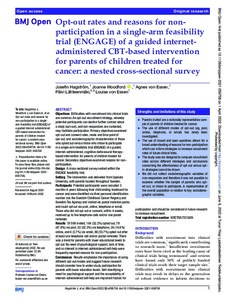Opt-out rates and reasons for non-participation in a single-arm feasibility trial (ENGAGE) of a guided internet-administered CBT-based intervention for parents of children treated for cancer: a nested cross-sectional survey
Hagström Josefin; Woodford Joanne; von Essen Agnes; Lähteenmäki Päivi; von Essen Louise
https://urn.fi/URN:NBN:fi-fe2022081153869
Tiivistelmä
Objectives Difficulties with recruitment into clinical trials are common. An opt-out recruitment strategy, whereby potential participants can decline further contact about a study (opt-out), and non-responders are contacted, may facilitate participation. Primary objectives examined opt-out and consent rates, mode and time point of opt-out, and sociodemographic characteristics of those who opted out versus those who chose to participate in a single-arm feasibility trial (ENGAGE) of a guided, internet-administered, cognitive-behavioural therapy-based intervention for parents of children treated for cancer. Secondary objectives examined reasons for non-participation.
Design A cross-sectional survey nested within the ENGAGE feasibility trial.
Setting The intervention was delivered from Uppsala University, with parents located throughout Sweden.
Participants Potential participants were recruited 3 months-5 years following their child ending treatment for cancer and were identified via their personal identification number (via the Swedish Childhood Cancer Registry and Swedish Tax Agency) and invited via postal invitation packs and could opt out via post, online, telephone or email. Those who did not opt out or consent, within 4 weeks, received up to five telephone calls and/or one postal reminder.
Results Of 509 invited, 164 (32.2%) opted out, 78 (47.6%) via post, 53 (32.3%) via telephone, 24 (14.6%) online, and 6 (3.7%) via email, 88 (53.7%) opted out after at least one telephone call and/or postal reminder. There was a trend for parents with lower educational levels to opt out. No need of psychological support, lack of time, and no interest in internet-administered self-help were frequently reported reasons for non-participation.
Conclusions Results emphasise the importance of using different opt-out modes and suggest future research should consider how to widen study participation for parents with lower education levels. Self-identifying a need for psychological support and the acceptability of internet-administered self-help are important factors for participation and should be considered in future research to increase recruitment.
Kokoelmat
- Rinnakkaistallenteet [27094]
